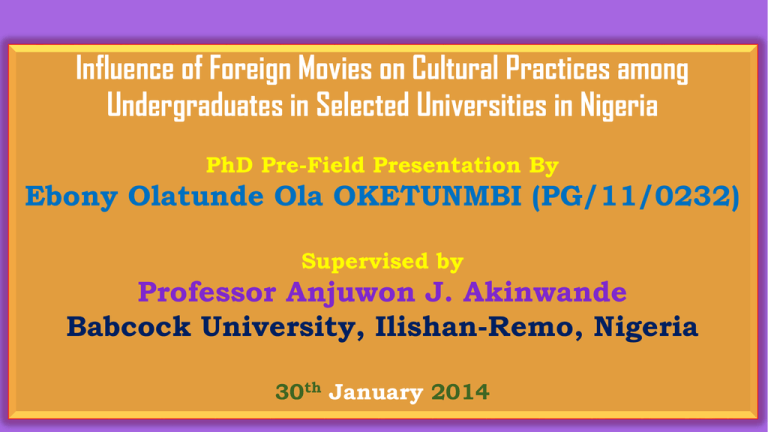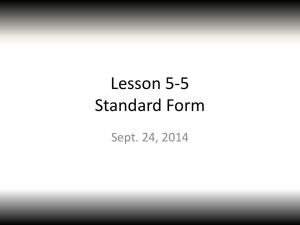
Influence of Foreign Movies on Cultural Practices among
Undergraduates in Selected Universities in Nigeria
PhD Pre-Field Presentation By
Ebony Olatunde Ola OKETUNMBI (PG/11/0232)
Supervised by
Professor Anjuwon J. Akinwande
Babcock University, Ilishan-Remo, Nigeria
30th January 2014
Observing Contemporary Undergraduates in Nigerian Universities:
(evidences of, in alphabetical order)
*Casual sex indulgence +
*Contempt for constituted authorities +
* Disregard for due process +
* Disdain for elders +
* Imported dress code +
* Inclination to aggression +
* Love of ‘the easy life’ +
* Mimicking of foreign role models +
* Strange manners of speaking +
* Unwholesome attitudes to work = ???
Authority (Cont.): Daine (2006) “Student’s exposure or lack of
exposure to foreign films influences their beliefs about other
cultures.”
Sokale (2007) “The culture of violence in foreign movies
culminate in proportional violent acts by teenagers in Nigeria.”
DNR Syed (2010) “Television is an electronic carpet which
seems to transport millions of persons each day to far off
places.”
1.2 Statement of the Problem
Scholars have incessantly and consistently indicted foreign movies of
viewers’ enculturation to the detriment of local cultures. They claim
that foreign movies sometimes culminate in undesirable changes in
cultural practices among members of particular cultures.
Empirical studies, such as Semiu (2011), support the indictment and
reveal that “Western films significantly influence the attitudes and
general lifestyles of Nigerian youths since most of them cannot resist
the contents of foreign films and they practice Western values
promoted in Western films at the expense of native cultures.”
1.2 Statement of the Problem (cont.)
The Daniel Ohikhena aeroplane stowaway saga is a fresh evidence that
frequent exposure to foreign movies undeniably influences behaviour.
However, there is inadequate research attention on the influence of
foreign movies in stimulating undesirable cultural changes among
specific demographic components of Nigeria. Since cultural
imperialism poses serious challenges to the purity and sustainability of
the Nigerian culture, research efforts in that direction is imperative.
Therefore, this study proposes to investigate the role of foreign movies
in cultural practices among undergraduates in the country.
1.3 Objectives of the Study
General objective: to determine the influence
of foreign movies on cultural practices
among undergraduates in Nigeria.
Specific objectives: 1,2,3,…8 as follow.
1.3 Objectives of the Study (Cont.)
1. To determine the types of foreign movies undergraduates in Nigeria prefer and why;
2. To determine the predominant themes in the types of foreign movies undergraduates in Nigeria prefer;
3. To determine the predominant dramatis personae in the types of foreign movies undergraduates in
Nigeria prefer;
4. To determine whether undergraduates in Nigeria are heavy viewers of foreign movies;
5. To determine whether frequency of exposure to foreign movies influences dress code, speech mode,
and adoption of behavioural role models among undergraduates in Nigeria;
6. To determine whether frequency of exposure to foreign movies stimulates violence among
undergraduates in Nigeria;
7. To determine whether undergraduates in Nigeria prefer foreign cultural practices and why;
8. To determine whether there is a correlation between frequency of exposure to foreign movies and
cultural practices among undergraduates in Nigeria.
DNR
1.4 Research Questions
1. Which types of foreign movies do undergraduates in Nigeria prefer and why?
2. What are the predominant themes in the types of foreign movies undergraduates in Nigeria prefer?
3. What are the predominant dramatis personae in the types of foreign movies undergraduates in Nigeria
prefer?
4. Are undergraduates in Nigeria heavy viewers of foreign movies?
5. Does frequency of exposure to foreign movies influences dress code, speech mode, and adoption of
behavioural role models among undergraduates in Nigeria?
6. Does frequency of exposure to foreign movies stimulates violence among undergraduates in Nigeria?
7. Do undergraduates in Nigeria prefer foreign cultural practices and why?
8. Is there a correlation between frequency of exposure to foreign movies and cultural practices among
undergraduates in Nigeria?
1.5 Research Hypotheses
H0 1: Foreign movies do not influence cultural
practices among undergraduates in Nigeria.
H0 2: There is no correlation between
frequency of exposure to foreign movies and
cultural practices among undergraduates in
Nigeria.
1.6 Significance of the Study
Useful reference material to parents and guardians who are
concerned about the continuity of their cultural heritage.
Contribution to knowledge on mass media contents effects.
Encourage reviews of the status of the NBC Code and its
stipulations on local-foreign content.
Inspire other mass media scholars to study the influence of
foreign movies on other populations.
1.6 Significance of the Study (Cont.)
Motivate bureaucrats and policy makers to work concertedly towards sustenance of beneficial
aspects of Nigeria’s cultural heritage and elevation of the country’s movies industry to worldclass standards.
Offer counsellors and authorities a deeper insight into the sources of influence of students’
behaviours.
Promote the enforcement of the NBC Code as it pertain to movies.
Remind stakeholders in Nollywood to find and attain the means of minimizing the competitive
edge of foreign film industries.
Shed more light on the roles of foreign movies in the cultural transmission and cultural
imperialism processes.
1.7 Scope and Limitations of the Study
Scope: Investigation of the influence of the independent variable,
foreign movies, on the dependent variable, cultural practices
(predominant dress code, language preference, worldview,
conduct towards elders, subjects of conversations, and manners of
speaking) among undergraduates in selected universities in
Nigeria.
Limitation: 1.Study environment (Academic, not social, religious,
home) 2. Univariate, not multivariate (individual differences, social
categories, ignorance, upbringing, and peer influence)
Univariate study =
Measures interplay
Single dependent variable
+
Single independent variable
Multivariate study =
Measures interplay
Multiple dependent variables
+
Single/multiple independent
variable(s)
2.1 Theoretical Framework
1. Cultivation theory
2. Cultural imperialism theory
3. Theory of mass media hegemony
Postulation of Cultivation Theory: Simulation of reality on television
proportionately influences perception of reality among heavy
viewers. The longer the period of exposure to the world as
portrayed on television, the more closely one would take
television as a true mirror of reality.
Relevance: If true, it is likely that frequent portrayal of Western
culture as the ideal life in foreign movies will influence
undergraduates preferred cultural practices. It influenced the
RQs 5, 6, 7, and 8.
Postulation of Cultural Imperialism Theory:
Powerful nations and economies culturally invade
less powerful countries and consequently impose
foreign practices on local cultures.
Relevance: If true, the theory suggests that
undergraduates in Nigeria may be under a cultural
siege due to pervasive exposure to foreign movies
mediated Western culture. It influenced RQ 8.
Postulation of Theory of Mass Media Hegemony:
In a capitalist society, the elites dominate social
subordinates based on consensus by both classes.
Relevance: If this is true, then undergraduates in Nigeria
may be unwittingly ‘consenting’ to the domination of
foreign movies mediated Western culture despite the
threat to the purity and sustenance of the local
culture. It influenced RQ 7.
3.1 Research Design
Based on triangulation, Research design =
Descriptive survey +
Analytic survey +
Content-analysis +
Observation methods.
Triangulation: Borrowed concept from marine navigation where using more than
one reference point or signal source enabled navigators to pinpoint an object’s
exact location.
Authority: Wimmer and Dominick 2011: 49; Osuala 2005: 183; Merrigan and Huston
2004: 50
3.1 Research Design (Cont.)
Relevance: It is “...the use of both qualitative
methods and quantitative methods to fully
understand the nature of a research problem”
and “...supplementing observational data with
data gathered by other means.” (Wimmer and
Dominick, 2011: 49, 126)
3.2 Populations of the Study
Primary Population: 1.6 million
undergraduates in public and private
universities located in Nigeria
Secondary Population: All types of
Hollywood/European movies popular
among undergraduates in Nigeria
3.3 Samples Sizes
From Primary Population:
1,250 undergraduates in Nigeria
From Secondary Population:
20 most popular Hollywood/European
movies among undergraduates
3.4 Sampling Techniques
For Primary Population:
Multi stage proportionate cluster sampling
Determining Proportion and Cluster
?
Sampling Tools:
1. Sampling Frame 1 (NUC Federal)
2. Sampling Frame 2 (NUC State)
3. Sampling Frame 3 (NUC Private)
4. Balloting Bag/Number
Table 3.1 Distributions of Universities in Nigeria by Ownership Type
Ownership Type
University Type and Frequency
Generalist
Total
Specialist
Federal
22.5% (n = 29)
8.5% (n = 11) 31.0% (n = 40)
State
20.9% (n = 27)
8.5% (n = 11)
29.5% (n = 38)
Private
37.2% (n = 48)
2.3% (n = 3)
39.5% (n = 51)
Total
80.6% (n = 104) 19.4% (n = 25) 100% (N = 129)
Therefore, ownership ratio of federal: states: private generalist universities in Nigeria = 29: 27: 48 = 1:1:2.
Source: Researcher’s analysis of data obtained from the National Universities Commission (NUC)’s website.
Table 3.2 Sampling Process in the Study
Stage
1
Sampling Activity
Adoption of three university clusters according to ownership types of federal,
states, and private with the aid of sampling frames 1, 2, and 3.
2
Selection of 10 universities by proportionate cluster sampling in the current
federal: states: private ownership ratio of 1:1:2.
3
Selection of 125 respondents from each of the 10 selected universities by simple
random sampling. Thus, sample size = 125 respondents × 10 universities = 1,250
Source: Researcher’s conceptualization of sampling process in the study
3.4 Sampling Techniques (Cont.)
For Secondary Population:
Purposive sampling technique by simple
frequency analysis
3.5 Research Instruments
1. Structured questionnaire
(Survey)
2.Structured code-sheet
(Content-Analysis)
3. Structured observation-guide
(Observation)
3.6 Validity and Reliability of Research Instruments
Questionnaire: Two consecutive pilot-tests on a test and
re-test basis among 5% (n = 63, N = 1,250) of primary
respondents.
Observation-guide: Test and re-test among 5% (n = 63, N =
1,250) of primary respondents.
Code-sheet: Test and re-test on popular movie genres
3.7 Administration of Instruments/Data Gathering Procedure
Questionnaire: Self-administration in each of selected 10
universities
Observation-guide: self-completed based on observations
of the respondents’ behaviours
Code-sheet: self-completed based on analyses of
contents of respondents’ foreign movies preference
3.8 Methods of Data Analysis
Tools:
*Statistical Package for Social Scientists (SPSS)
*Chi square statistics
*Simple percentages
*Cross-tabulations
Presentation: pie-charts, bar graphs, et cetera









